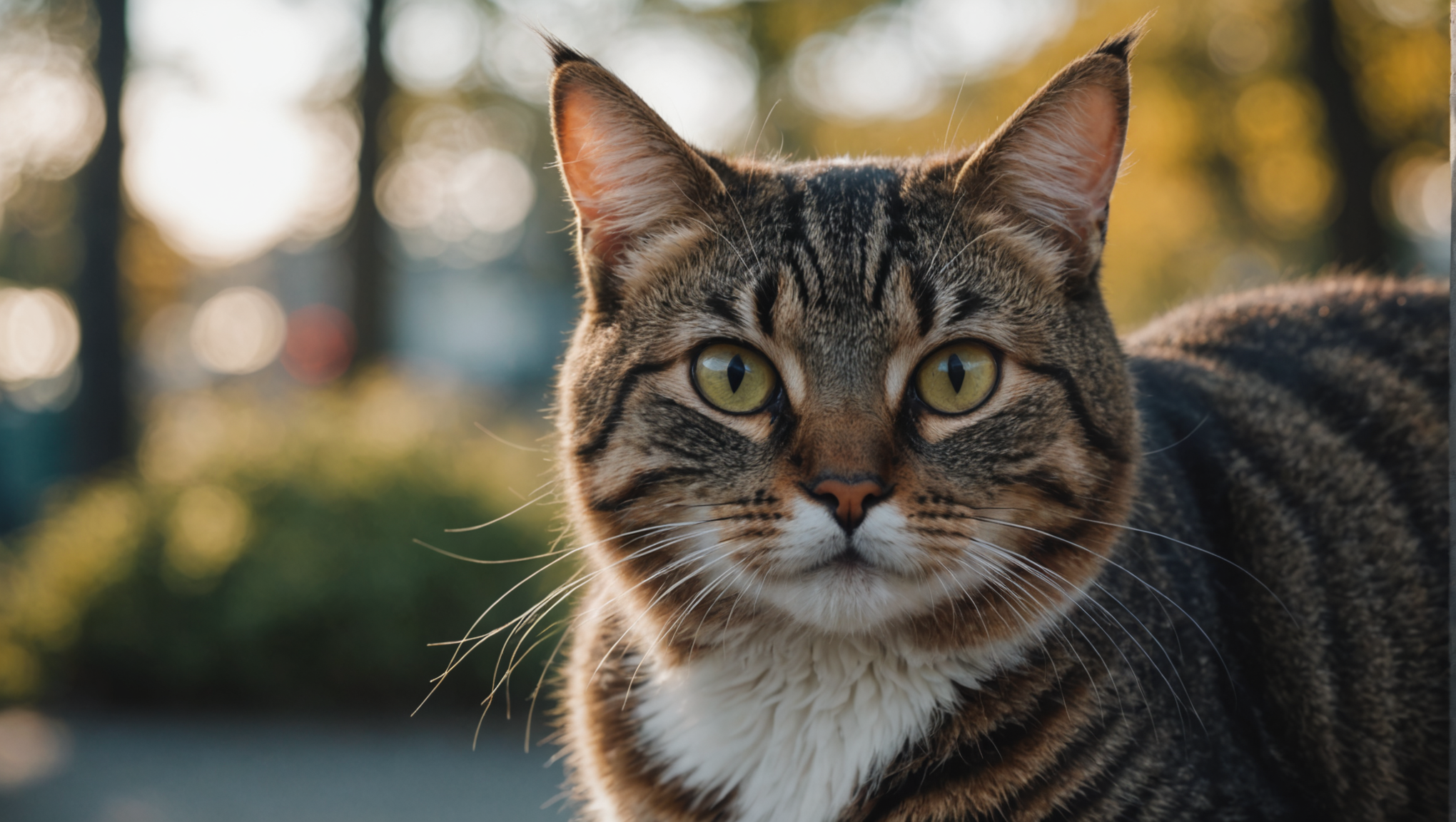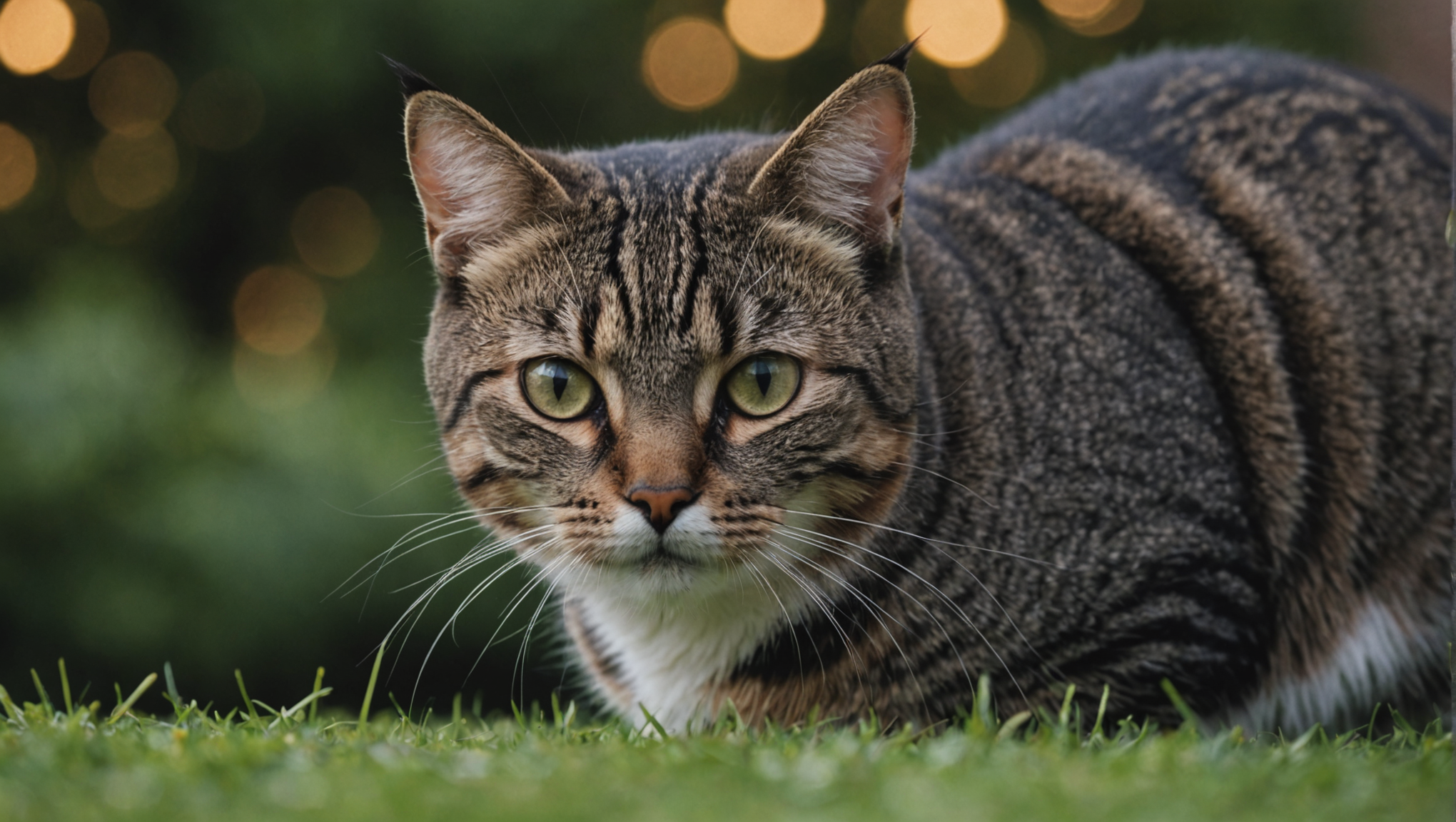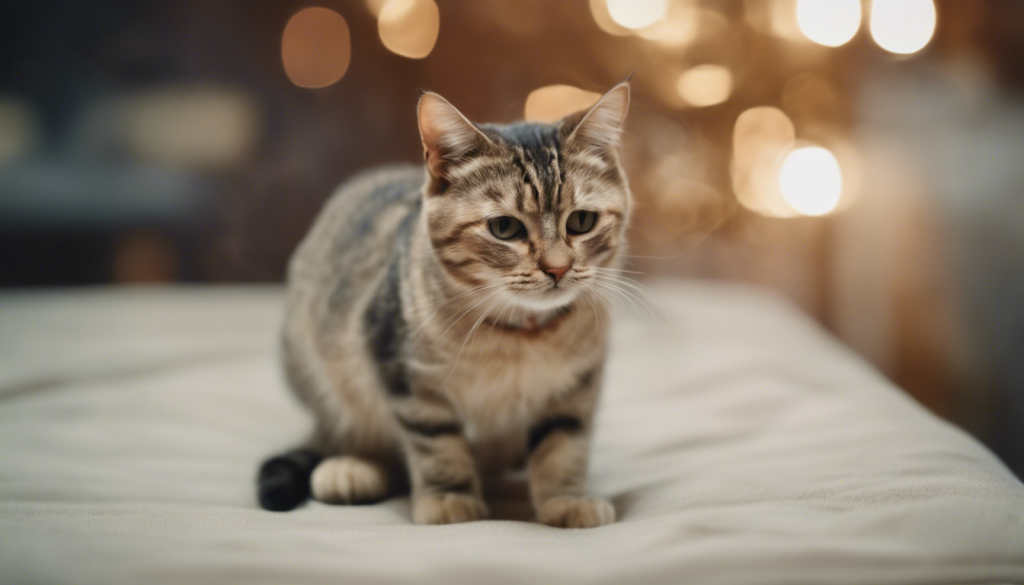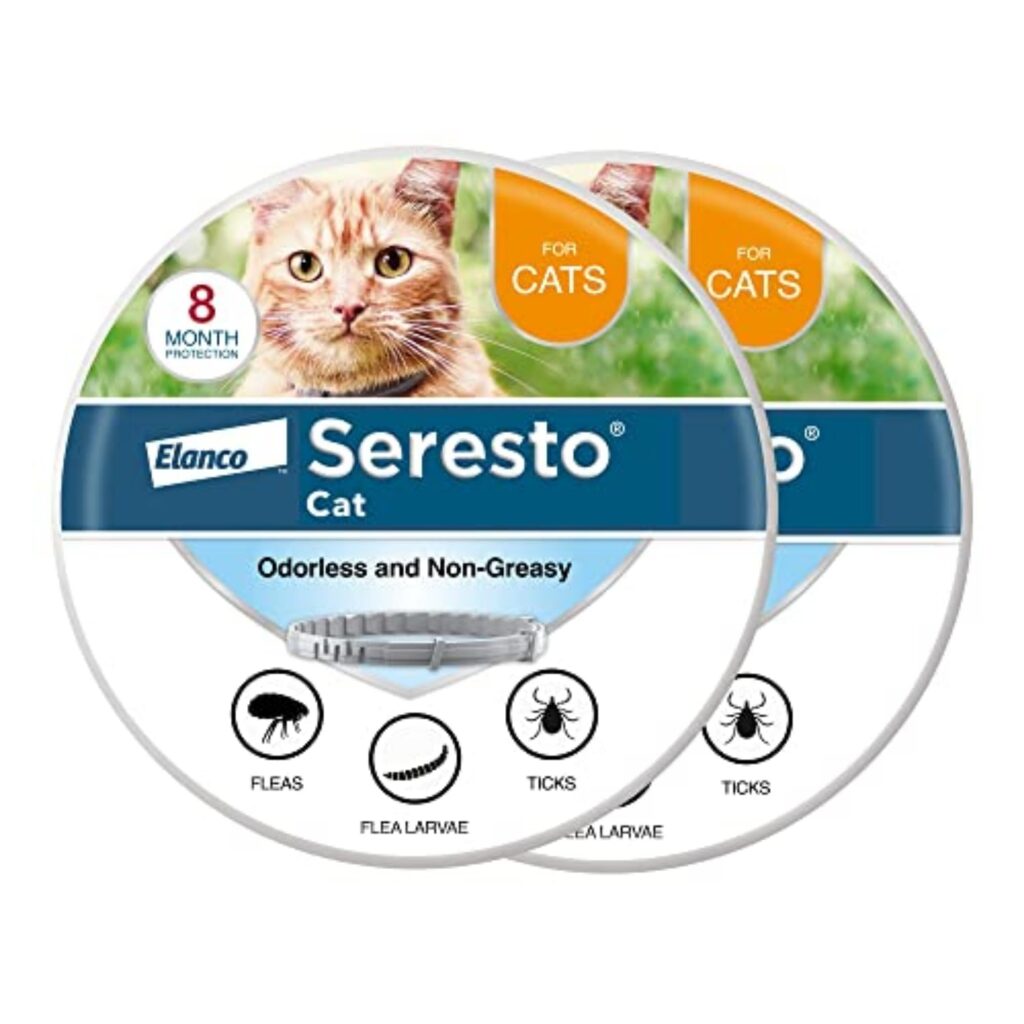
In the intricate tapestry of feline existence, territory marking emerges as a profound manifestation of a cat’s instinctual behaviors, echoing the primal rhythms of nature that dictate not merely survival but the very essence of communication among their kind. Within the confines of our domestic worlds, these elegant creatures engage in marking their territories, a nuanced dialogue expressed through an array of behaviors—from the delicate yet purposeful scratching of claws to the unmistakable scent deposits meticulously placed to assert their presence. Each tactile or olfactory signal serves as a complex narrative, rich with information about their individuality, reproductive status, and the emotional landscape they traverse.
The significance of territory marking transcends mere territoriality; it represents an assertion of identity, a claim over that which is familiar and safe. Within the sprawl of household corners and the familiar contours of furniture, a marked space becomes a sanctuary infused with the history of their experiences and interaction, a veritable gallery housing the scents of their predecessors shaped by moments of playfulness, contentment, and perhaps even anxiety. This act of marking is intertwined with a cat’s well-being; through such behaviors, they find solace in creating a world that is distinctly theirs, fostering an environment where they can thrive.
Understanding the motivations driving this behavior requires a closer look at the multifaceted needs of the feline psyche. Cats possess an intricate sense of smell, one far more sophisticated than that of humans, and through scent marking, they communicate on an entirely different plane of existence—one fraught with nuances and subtleties that may elude the untrained observer. As they traverse their territory, leaving behind traces of their essence, they imbue their world with elements that stir their feelings of safety and ownership. Thus, habitual markings can serve as a soothing mechanism, a way for them to reaffirm their place in a sometimes bewildering environment.
Moreover, we must recognize the ritualistic nature embedded within marking behaviors. Just as we might decorate our homes to reflect our identities, so too do cats employ their unique forms of expression. The soft scratch of a paw against a favorite post can be likened to a stroke of artistry, each mark laid with intention, fostering a sense of continuity in their increasingly dynamic surroundings. This inclination to mark territory may also serve as an emotional buffer against potential upheavals, such as the introduction of new pets or changes in the household structure. When faced with uncertainty, a cat’s instinctive drive to scent mark becomes heightened, functionally reinforcing their control amidst the shifting landscapes of their lives.
Thus, as we ponder the profound implications of territory marking, it is essential to approach this behavior not merely with a lens of observation but with a profound appreciation for its role in the psychological and emotional well-being of our feline companions. A cat’s health, both mental and physical, is intertwined with their ability to establish and maintain a territory that resonates with familiarity and comfort, transforming their immediate surroundings into a personal haven where they can navigate the complexities of their existence.
In acknowledging the intricacy of such behaviors, we foster a more profound understanding of what it means to share our lives with these enigmatic creatures—recognizing not only their need for a well-defined territory but also the delicate balance that sustains their health and happiness.
Common reasons for territory marking
Yet, as we delve deeper into the realm of this territorial instinct, it becomes increasingly evident that the reasons behind such marking behavior are not merely limited to a mere assertion of dominance or ownership, but rather reflect a rich tapestry of emotional and physical needs intertwined with the very essence of feline identity. The diverse motivations may, for instance, stem from the inherently social nature of certain breeds, responding to the multifaceted dynamics that emerge within their domestic sanctuaries. For instance, a cat may exhibit heightened territorial marking in response to the presence of new animals or even unfamiliar humans, as if to herald their own sentiment of belonging amidst a perceived encroachment on their established domains.
Moreover, it is imperative to acknowledge how the transient states of feline health can heavily influence marking behavior. A cat suffering from stress, anxiety, or even illness may resort to an increase in such actions, seeking solace in the familiar scents and identifiers of their environment as they grapple with discomfort. This serves as a poignant reminder that emotional disturbances can manifest outwardly, often taking form through the very act of marking. Cats, in essence, become barometers of the wellness of their environment; their behaviors, social interactions, and marking rituals serve as reflections of their internal landscapes.
In instances of spaying or neutering, changes in hormonal influences can significantly alter a cat’s proclivity towards territory marking. An intact male cat, with his robust drive underpinned by testosterone, may engage in more pronounced marking as a means to attract prospective mates or assert his physical presence within a competitive social milieu. Conversely, neutered males or spayed females might exhibit declining territorial behaviors, thereby suggesting a notable interplay between reproductive status and marking tendencies. This complex relationship underscores the importance not only of understanding the inherent biological rhythms at play but also of acknowledging the larger narrative of how these rhythms are affected by the decisions we make regarding their health and well-being.
Additionally, environmental factors cannot be overlooked when assessing a cat’s motivations for marking behavior. An array of stimuli, from the introduction of a new furniture piece to the faint scent of a neighbor’s cat wafting through the open window, can induce a response that sends these felines into their instinctive performances. Instinctively, they may take it upon themselves to reclaim what feels like a threatened domain, resulting in vigorous marking that speaks volumes of their inherent need for security against an onslaught of what they perceive to be unwelcome competition.
It’s within these nuanced interactions between biology, environment, and emotion that we come to appreciate the multifaceted reality of feline territory marking. The act is far from a singular expression of possessiveness; instead, it embodies a complex interplay through which our cats navigate their lives, employing bewildering strategies to reclaim agency. This realization invites a greater empathy into our handling of such behaviors, urging us to create an environment where they feel not just secure, but interconnected with their surroundings—a realm where they can flourish as the magnificent fragments of nature they are.
Ultimately, to decipher the language of territory marking is to unlock a deeper, more enriching relationship with our feline companions, allowing us to better comprehend their needs, fears, and the myriad of emotions that shape their world. In embracing every quirk and unconventional behavior, we honor the rich inner lives of our cats, opening ourselves to the profound beauty nested within the intricate connections that bind us to these extraordinary beings.
Signs of excessive marking behavior
Exceeding the bounds of typical behavioral expressions, excessive territory marking presents a profound tableau of a cat’s emotional state, often signaling underlying discomfort or psychological discord. When the delicate balance of marking transforms into a pattern that appears compulsive or unyielding, it beckons the attentive guardian to decipher the subtleties reflecting their feline’s tumultuous inner workings. A cat that engages in what may seem like relentless scent deposition, whether through urine marking or rigorous claw scratching, is not merely asserting dominance; rather, they may be communicating distress, anxiety, or an instinctive response to perceived threats.
One might observe telltale signs—urination in conspicuous places across the domestic landscape, or the frequent and unnecessary scratching of furniture and carpets—elements that transcend the mere desire for territorial proclamation. Such behaviors can emerge when environmental shifts occur with unexpected rapidity, as if a chasm of stability has suddenly surface-altered within their familiar realm. The introduction of a new pet or varying family dynamics can provoke a cat’s fierce need to reaffirm its presence, manifesting in an escalation of marking behaviors. As a ruling ethos seems to erupt from their core, it becomes evident that they’re engaged in a battle of self-assertion and emotional turmoil.
The attentive observer may note not only the frequency of these behaviors but their intensity. Does your cat engage in marking only during specific events, or has it become an all-consuming ritual? For instance, a once-calm cat may adopt an almost frenetic pace in their marking when confronted by the unwelcome arrival of new household members. This territorial assertion, born of insecurity, can ultimately lead to a cascade of further behavioral complications, creating a chronic cycle of anxiety that feels inescapable for the afflicted feline. The sight of a beloved feline companion embroiled in such turmoil can be heartbreaking; the very essence of their identity appears to unravel in the face of perceived invasion.
Moreover, the sensory world in which cats operate necessitates a deeper understanding of the repercussions of excessive marking. Beyond merely disturbing household harmony, the voluminous olfactory signatures left behind can suffuse the environment with an overwhelming sense of tension and disarray, thereby exacerbating an already precarious situation. Cats possess a keen sense of smell that governs their emotions; excessive marking may not only clutter their immediate surroundings but also muffle their intrinsic sense of safety. Each marking becomes a layered narrative, infused with anxiety that reverberates within their sanctuary, compelling them into a cycle fraught with discomfort.
For instance, ponder the common scenario where a single family cat, once the undisputed sovereign of its realm, suddenly finds itself in a competition for attention, affection, or space. The resultant marking could be perceived as a cry for assurance of its place within the familial hierarchy. The profound disquiet felt by such a noble creature may emerge in frantic shreds—lavish displays of their essence and scent, creating a tapestry of perfumed anxiety that taints not just physical territory but emotional security.
In addressing excessive marking behavior, transparency emerges as a vital element—a dialogue between the human guardian and their feline counterpart, enriched by empathy and understanding. Recognizing such signs as potent indicators of distress encourages a broader exploration into the cat’s emotional landscape. The mere act of observing marking behavior can unveil a Pandora’s box of underlying issues—be they stress-induced, health-related, or a product of environmental instabilities—each demanding meticulous attention. In creating an atmosphere where reassurance abounds—whether through environmental enrichment, behavioral modification, or addressing health concerns—guardians can foster healing and stability, allowing their cats to reclaim the harmonious territory that once embodied safety.
Thus, as we unravel the complexities embedded within excessive territory marking, it becomes essential to navigate the terrain with both compassion and strategy, elucidating the multifaceted dialogues our feline companions engage in. Such understanding paves the way for nurturing their well-being, leading to a harmonious coexistence marked not by anxiety and chaos, but by joy and mutual regard. By cultivating an awareness of their emotional and physical needs, we create a sanctuary wherein our beloved cats can flourish, anchored in a world crafted with love and understanding.

Strategies to manage territory marking
To embark on the journey of managing territory marking is to engage in a dance of delicate balance—a choreography where the needs and instincts of the feline intertwine with the aspirations of their human custodians. Within the labyrinthine corridors of a cat’s psyche, solutions flourish not from imposition but from an attuned understanding, an empathetic endeavor to re-establish harmony. As guardians of these graceful creatures, we can introduce a plethora of strategies that cater to their instinctual drives while fostering a tranquil coexistence.
Firstly, the introduction of a robust and engaging environment cannot be understated. A stimulating space laden with vertical perches, interactive toys, and mesmerizing scratching posts invites exploration and promotes natural behaviors that can absorb the energies typically channeled into marking. By creating a cornucopia of opportunities for play and autonomy, we can extend an olive branch to our cats, allowing them to engage in territory management through healthy outlets. This approach not only diverts their marking instincts but also reinforces their emotional well-being, providing a canvas upon which they can paint their confidence and sense of security.
In tandem, employing scent enrichment within the environment emerges as a potent strategy—a fragrant invitation to redirect their attention and instincts. While our human sensibilities perceive aromas in strictly functional terms, for cats, scent is woven into the fabric of their identity. Incorporating calming scents such as lavender or chamomile into their surroundings may soothe anxiety and diminish the impulse to assert territory through marking. Moreover, synthetic feline pheromones, available in diffusers or sprays, can replicate the comfort of a mother’s presence, offering reparation to the emotional fabric of the home, thus creating a sanctuary steeped in tranquility.
Behavioral modification techniques stand as another pillar of intervention, necessitating patience and consistency. Acquisition of the cue phrase, using a simple “no” followed by distraction with toys, can gradually inform the cat that unwanted marking is not favored, all the while redirecting their attention to more acceptable behaviors. Training sessions that incorporate positive reinforcement, such as treats or affection, when they engage appropriately with their environment can establish a dialogue of understanding and compliance, transforming the territory into a realm of cooperation and companionship.
Furthermore, the holistic assessment of the cat’s health emerges as a fundamental component in the strategy to diminish marking behavior. Regular veterinary consultations not only serve to identify underlying medical concerns that could contribute to marking behaviors, such as urinary tract infections or hormonal imbalances, but also empower cat owners with knowledge concerning spaying or neutering implications. Such measures, when pursued thoughtfully, may yield a noteworthy reduction in marking inclination, crafting a path toward a profound transformation in the feline experience.
The rhythm of daily life also demands consideration; thus, establishing a consistent schedule imbued with predictability can greatly benefit anxious cats. Regular feeding times, play sessions, and moments of bonding create a framework upon which stability can blossom, allowing the cat to associate control and safety within their routine. In this manner, a cat may find solace amidst a world that often feels rife with unpredictability, diminishing the compulsion to affirm their territory through excessive marking.
In instances where the social dynamics within the household may challenge a cat’s sense of security, gradual introductions of new pets or modifications to their environment should be approached with care. Using barriers such as baby gates or separate spaces during initial encounters can cultivate a sense of agency and control. With the patient’s dedication of their human counterparts, cats can be reassured that even amidst change, their territory remains steadfast, bolstered by the familiar scents and sounds that enrich their daily existence.
Ultimately, the journey of managing territory marking unfolds within a tapestry of strategies that honor the intrinsic qualities of cats—instincts shaped by evolution, emotional sensibilities, and individual experiences. Through empathy, awareness, and deliberate action, we can navigate this nuanced landscape, transforming challenges into opportunities for deeper connection, fostering a shared world that resonates with understanding, joy, and tranquility. Each careful step taken not only enhances the quality of life for our feline friends but solidifies the bond that ties our hearts within this intricate dance of cohabitation, one paw at a time.
Behavioral interventions and solutions
Within the rich spectrum of behavioral interventions that can alleviate the often burdensome rituals of territory marking, it’s imperative to approach the matter with a lens of nuanced empathy and strategic foresight. The labyrinthine nature of feline psychology calls for guardians to adopt a holistic perspective, recognizing that the solutions sought are not merely about curtailing undesirable actions, but rather nurturing a profound sense of stability and comfort within the feline’s psyche. To weave a tapestry of tailored interventions necessitates an understanding of the multifaceted quilt of individual temperament and situational variables that each cat embodies.
To begin, fostering a secure environment stands as the cornerstone of effective intervention; cats, being creatures of habit and predictability, greatly benefit from a stable home. Establishing a sanctuary imbued with familiarity facilitates their emotional well-being, reducing the compulsion to mark. Organizing the physical space in a manner that delineates ‘safe zones’ enables cats to assert ownership over these areas without resorting to marking. Creating designated spaces for each cat—including cozy perches, enclosed hiding spots, or even sheer expanses of window sills—allows them to imbue their surroundings with their scent in a manner that feels organic and at ease, rather than defensive.
Moreover, the gentle incorporation of pheromonal aids into the environment can invoke a profound sense of relaxation and security. The strategic deployment of synthetic pheromone diffusers serves to mimic the reassuring scents that a cat uses to mark their territory naturally. When the household is suffused with calming pheromones reminiscent of maternal safety, the cat’s instinctive anxiety may significantly diminish, consequently reducing their need for excessive marking as they find comfort in the aura of familiarity. These scent-based strategies also work harmoniously alongside the elevation of their sensory environment—a myriad of textures, climbing opportunities, and olfactory stimuli invites not just exploration but also diminishes the urgency to claim territory through traditional marking methods.
The implementation of behavioral modification techniques, too, demands both finesse and patience. Introducing a consistent cue alongside a rewarding distraction—a beloved toy or play activity—can effectively redirect the cat’s attention away from the impulse to mark. As guardians, our role transforms into that of a gentle guide; rewarding moments of calm and relaxation reinforces desirable behaviors, facilitating a positive feedback loop. Through repetition and consistency, the cat gradually learns to associate certain actions with pleasant outcomes, leading to a reformation of behavioral patterns that favor harmony over disruption.
Additionally, the integration of routine within daily life emerges as a potent tool in stabilizing the emotional climate for our feline companions. Establishing fixed feedings, play sessions, and quiet periods cultivates predictability—a veritable anchor amidst the currents of change that may otherwise provoke insecurity. The rhythm of predictable interactions mirrors the nurturing embrace of a maternal figure, helping to instill trust and a sense of control within their environment. Thus, the cat begins to navigate their world with greater assurance, and the resultant tranquility diminishes the urgency to assert themselves through territorial marking.
For those instances where social dynamics intrude upon the peace of an established household, gradual introductions of new members—be they animal or human—should be orchestrated with deliberation akin to a well-rehearsed dance. Allowing time for acclimatization and using visual barriers can allow the resident cat to acclimate to new scents and sounds at their own pace, reducing feelings of encroachment. The shared spaces of our homes, once susceptible to assertion through marking, transform into realms of collaboration and shared coexistence, when introduced thoughtfully.
Furthermore, an acknowledgment of the underlying health concerns that might amplify marking behavior cannot be overstated. Regular health assessments serve not only to uncover potential medical impediments that affect behavior but also engage guardians in a dialogue about the proactive care of their feline companions. Comprehensive veterinary consultations can illuminate connections between hormonal fluctuations and behavioral manifestations; medical interventions, including spaying or neutering, often yield significant alleviation of the innate compulsion to mark. Understanding these biological rhythms facilitates a holistic approach where health and behavior become intertwined components of a broader strategy embraced by both cat and guardian.
Thus, navigating the nature of territory marking through behavioral interventions is akin to composing a symphonic arrangement—a delicate balance of melody and harmony, wherein each note matters. Through observational insight, tailored strategies, and compassionate guidance, we create a nurturing framework within which our feline friends can explore, claim, and inhabit their territory without the specter of distress. As the layers of anxiety peel away, what emerges is not merely a cessation of marking, but a profound celebration of connection and companionship, enveloping our lives in the serene beauty of mutual understanding and respect. Each intervention becomes a brushstroke, painting a portrait of coexistence filled with trust, joy, and the essence of shared lives forged in the crucible of love.
When to seek professional help
In addressing the complexities inherent within the realm of territory marking, the decision to seek professional help becomes not merely a measure of last resort, but rather a vital step in ensuring the holistic well-being of our beloved feline companions. The delicate interweaving of physical health, emotional stability, and behavioral expression often necessitates the guidance of experts who can offer insights and solutions transcending the scope of casual observation. In recognizing when it is time to engage with professionals, we embrace a proactive stance that serves both the cat and the human, illuminating the pathway to a harmonious cohabitation.
When excessive marking behavior escalates beyond the realm of occasional display—transforming into a pattern fraught with frequency and intensity—the signs become unmistakable. It is within this context of persistent action, often underscored by apparent distress, that the need for intervention surfaces. Perhaps your feline companion has begun to forsake the litter box in favor of uncharted territories of your home, or the once-cherished scratching post has been replaced by the couch as a canvas for their territorial declarations. Such manifestations should kindle a flame of concern that prompts you to consider professional input, as the markings—a mélange of scent and intention—begin to morph into cries for help, laden with the weight of their emotional tumult.
Moreover, an exploration into the underlying causes of distress penetrating your cat’s psyche merits the scrutiny of a veterinarian or a feline behaviorist. Many medical conditions can precipitate changes in marking behavior, from hormonal imbalances to urinary tract infections that compel an innocent cat to assert control over its surroundings in profound frustration. The keen insight afforded by experts can unveil hidden maladies that, once treated, can restore peace to the feline’s mind and environment, transforming a household characterized by upheaval back into a haven of tranquility.
The emotional nature of a cat is multifaceted and often intricately tied to their surrounding dynamics. A significant change—a new arrival in the household, the departure of a family member, or even the subtle shift in routines—can catalyze a tumultuous response. These transitions, though innocuous to the human eye, may send ripples of insecurity cascading through a cat’s consciousness, leading them to resort to marking as a means of reestablishing control over an increasingly disconcerting environment. Herein lies the importance of expert guidance: professionals equipped with the skill to navigate the treacherous waters of feline psychology can devise tailored strategies aimed at mitigating anxiety, augmenting the cat’s sense of security, and ultimately fostering a greater sense of belonging.
Equally essential is the acknowledgment of the emotional toll that both the marking behavior and its repercussions can exert upon the guardians themselves. A continuous cycle of cleaning, potential damage to cherished possessions, and the weight of worry can precipitate stress that seeps into the fabric of daily life. This emotional burden may lead to frustration or sadness, which can unintentionally affect the cat’s emotional state, thereby perpetuating the behavior. In seeking professional help, not only is the plight of the cat addressed, but the emotional well-being of the entire household is also attended to, allowing each member to rediscover the joys of companionship minus the overshadowing specter of anxiety.
Beyond the immediate household, professional help can also encompass broader communal resources, such as cat behavior workshops or classes that encourage socialization and education among feline guardians. Engaging with a community of like-minded individuals fosters a sense of solidarity and understanding, where strategies are shared and experiences are exchanged. Such collective action not only empowers guardians but also reinforces the notion that navigating the intricate nature of feline behavior is seldom a solitary endeavor—each cat and guardian dance a duet embellished with shared struggles and triumphs.
In summation, the decision to seek professional help when faced with excessive territory marking transcends the mere act of addressing a behavioral nuisance; it evolves into an essential commitment to the well-being of a cherished companion. Through seeking expertise, understanding the intricacies of feline behavior, and cultivating an informed response, we embark upon a journey that intertwines the threads of compassion, knowledge, and ultimately, love. This holistic endeavor illuminates the path toward not just a well-marked territory but a realm suffused with the boundless joys of partnership, a sacred space where understanding flourishes and both feline and human thrive.







